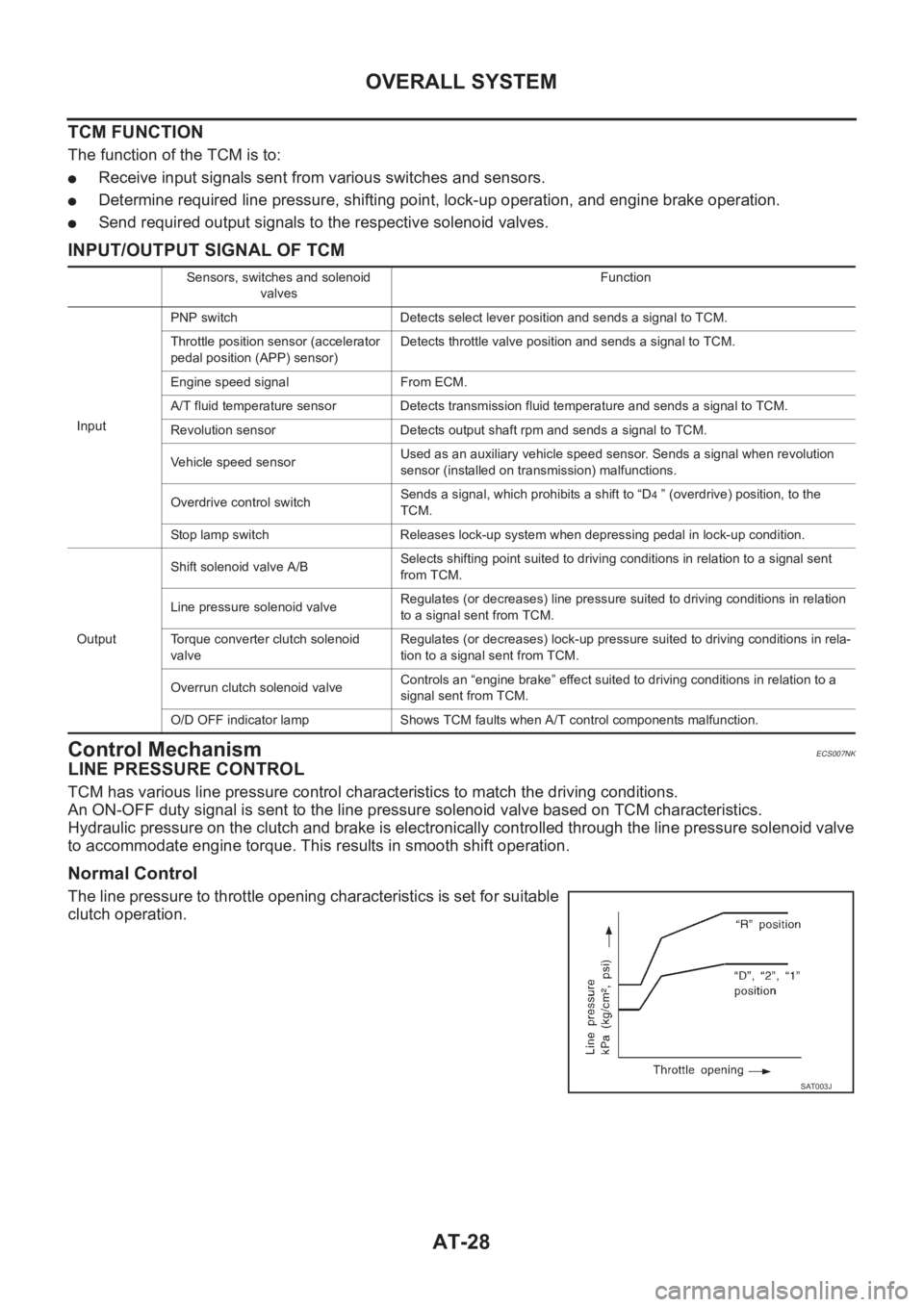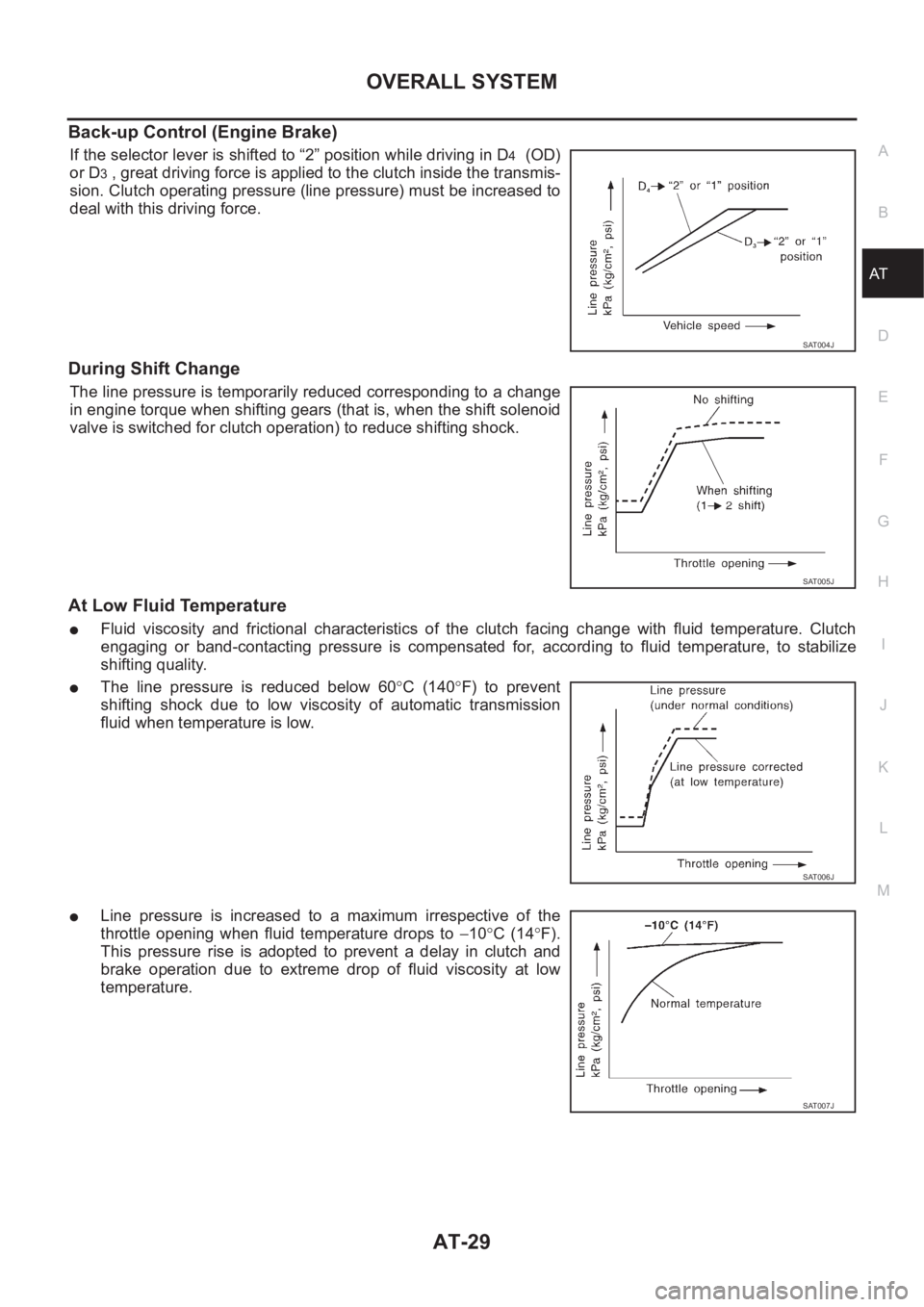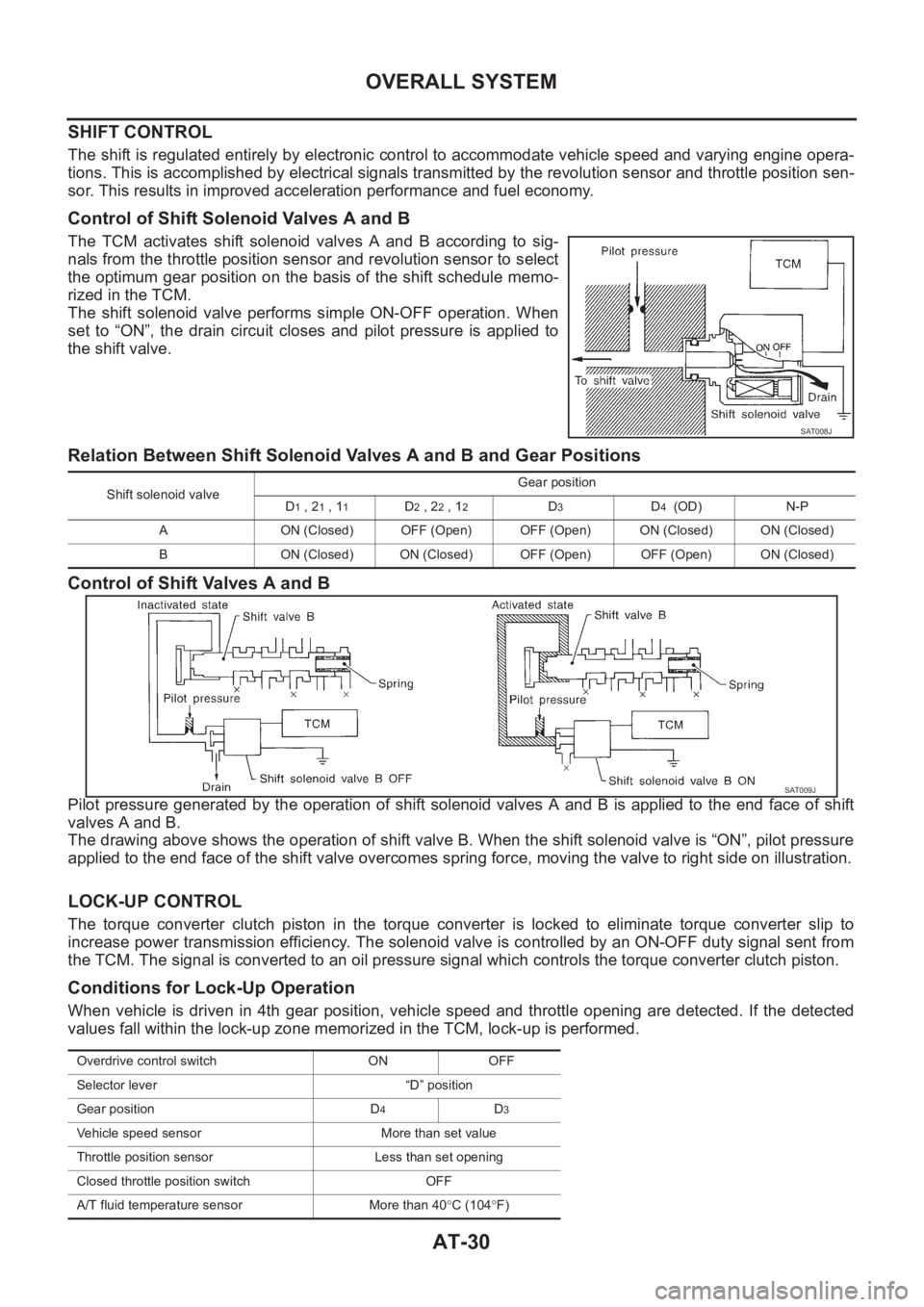Page 1481 of 3189
OVERALL SYSTEM
AT-25
D
E
F
G
H
I
J
K
L
MA
B
AT
“D4 ” (OD) Position
●High clutch
●Brake band
●Forward clutch (Does not affect power
transmission)Input power is transmitted to front planetary carrier through high clutch.
This front planetary carrier turns around the front sun gear which is fixed by brake
band and makes front internal gear (output) turn faster.
Engine brakeAt D
4 position, there is no one-way clutch in the power transmission line and engine
brake can be obtained when decelerating.
SAT380J
Page 1482 of 3189
AT-26
OVERALL SYSTEM
“R” Position
●Reverse clutch
●Low and reverse brakeFront planetary carrier is stationary because of the operation of low & reverse brake.
Input power is transmitted to front sun gear through reverse clutch, which drives front
internal gear in the opposite direction.
Engine brakeAs there is no one-way clutch in the power transmission line, engine brake can be
obtained when decelerating.
SAT381J
Page 1484 of 3189

AT-28
OVERALL SYSTEM
TCM FUNCTION
The function of the TCM is to:
●Receive input signals sent from various switches and sensors.
●Determine required line pressure, shifting point, lock-up operation, and engine brake operation.
●Send required output signals to the respective solenoid valves.
INPUT/OUTPUT SIGNAL OF TCM
Control MechanismECS007NK
LINE PRESSURE CONTROL
TCM has various line pressure control characteristics to match the driving conditions.
An ON-OFF duty signal is sent to the line pressure solenoid valve based on TCM characteristics.
Hydraulic pressure on the clutch and brake is electronically controlled through the line pressure solenoid valve
to accommodate engine torque. This results in smooth shift operation.
Normal Control
The line pressure to throttle opening characteristics is set for suitable
clutch operation.
Sensors, switches and solenoid
valvesFunction
InputPNP switch Detects select lever position and sends a signal to TCM.
Throttle position sensor (accelerator
pedal position (APP) sensor)Detects throttle valve position and sends a signal to TCM.
Engine speed signal From ECM.
A/T fluid temperature sensor Detects transmission fluid temperature and sends a signal to TCM.
Revolution sensor Detects output shaft rpm and sends a signal to TCM.
Vehicle speed sensorUsed as an auxiliary vehicle speed sensor. Sends a signal when revolution
sensor (installed on transmission) malfunctions.
Overdrive control switchSends a signal, which prohibits a shift to “D
4 ” (overdrive) position, to the
TCM.
Stop lamp switch Releases lock-up system when depressing pedal in lock-up condition.
OutputShift solenoid valve A/BSelects shifting point suited to driving conditions in relation to a signal sent
from TCM.
Line pressure solenoid valveRegulates (or decreases) line pressure suited to driving conditions in relation
to a signal sent from TCM.
Torque converter clutch solenoid
valveRegulates (or decreases) lock-up pressure suited to driving conditions in rela-
tion to a signal sent from TCM.
Overrun clutch solenoid valveControls an “engine brake” effect suited to driving conditions in relation to a
signal sent from TCM.
O/D OFF indicator lamp Shows TCM faults when A/T control components malfunction.
SAT003J
Page 1485 of 3189

OVERALL SYSTEM
AT-29
D
E
F
G
H
I
J
K
L
MA
B
AT
Back-up Control (Engine Brake)
If the selector lever is shifted to “2” position while driving in D4 (OD)
or D
3 , great driving force is applied to the clutch inside the transmis-
sion. Clutch operating pressure (line pressure) must be increased to
deal with this driving force.
During Shift Change
The line pressure is temporarily reduced corresponding to a change
in engine torque when shifting gears (that is, when the shift solenoid
valve is switched for clutch operation) to reduce shifting shock.
At Low Fluid Temperature
●Fluid viscosity and frictional characteristics of the clutch facing change with fluid temperature. Clutch
engaging or band-contacting pressure is compensated for, according to fluid temperature, to stabilize
shifting quality.
●The line pressure is reduced below 60°C (140°F) to prevent
shifting shock due to low viscosity of automatic transmission
fluid when temperature is low.
●Line pressure is increased to a maximum irrespective of the
throttle opening when fluid temperature drops to −10°C (14°F).
This pressure rise is adopted to prevent a delay in clutch and
brake operation due to extreme drop of fluid viscosity at low
temperature.
SAT004J
SAT005J
SAT006J
SAT007J
Page 1486 of 3189

AT-30
OVERALL SYSTEM
SHIFT CONTROL
The shift is regulated entirely by electronic control to accommodate vehicle speed and varying engine opera-
tions. This is accomplished by electrical signals transmitted by the revolution sensor and throttle position sen-
sor. This results in improved acceleration performance and fuel economy.
Control of Shift Solenoid Valves A and B
The TCM activates shift solenoid valves A and B according to sig-
nals from the throttle position sensor and revolution sensor to select
the optimum gear position on the basis of the shift schedule memo-
rized in the TCM.
The shift solenoid valve performs simple ON-OFF operation. When
set to “ON”, the drain circuit closes and pilot pressure is applied to
the shift valve.
Relation Between Shift Solenoid Valves A and B and Gear Positions
Control of Shift Valves A and B
Pilot pressure generated by the operation of shift solenoid valves A and B is applied to the end face of shift
valves A and B.
The drawing above shows the operation of shift valve B. When the shift solenoid valve is “ON”, pilot pressure
applied to the end face of the shift valve overcomes spring force, moving the valve to right side on illustration.
LOCK-UP CONTROL
The torque converter clutch piston in the torque converter is locked to eliminate torque converter slip to
increase power transmission efficiency. The solenoid valve is controlled by an ON-OFF duty signal sent from
the TCM. The signal is converted to an oil pressure signal which controls the torque converter clutch piston.
Conditions for Lock-Up Operation
When vehicle is driven in 4th gear position, vehicle speed and throttle opening are detected. If the detected
values fall within the lock-up zone memorized in the TCM, lock-up is performed.
SAT008J
Shift solenoid valveGear position
D1 , 21 , 11D2 , 22 , 12D3D4 (OD) N-P
A ON (Closed) OFF (Open) OFF (Open) ON (Closed) ON (Closed)
B ON (Closed) ON (Closed) OFF (Open) OFF (Open) ON (Closed)
SAT009J
Overdrive control switch ON OFF
Selector lever “D” position
Gear position D
4D3
Vehicle speed sensor More than set value
Throttle position sensor Less than set opening
Closed throttle position switch OFF
A/T fluid temperature sensor More than 40°C (104°F)
Page 1519 of 3189
TROUBLE DIAGNOSIS — BASIC INSPECTION
AT-63
[EURO-OBD]
D
E
F
G
H
I
J
K
L
MA
B
AT
TROUBLE DIAGNOSIS — BASIC INSPECTIONPFP:00000
A/T Fluid CheckECS007NW
FLUID LEAKAGE CHECK
1. Clean area suspected of leaking. — for example, mating surface
of converter housing and transmission case.
2. Start engine, apply foot brake, place selector lever in “D” posi-
tion and wait a few minutes.
3. Stop engine.
4. Check for fluid leakage.
FLUID CONDITION CHECK
FLUID LEVEL CHECK
Refer to AT-13, "Checking A/T Fluid" .
SAT767B
SAT288G
Fluid color Suspected problem
Dark or black with burned odor Wear of frictional material
Milky pink Water contamination — Road water
entering through filler tube or breather
Varnished fluid, light to dark brown and
tackyOxidation — Over or under filling, —
Overheating
SAT638A
Page 1555 of 3189
![NISSAN ALMERA N16 2003 Electronic Repair Manual TROUBLE DIAGNOSIS — GENERAL DESCRIPTION
AT-99
[EURO-OBD]
D
E
F
G
H
I
J
K
L
MA
B
AT
Races extremely fast or slips in
changing from “D
4 ” or “D3 ” to “D1 ”
when depressing accelerator p NISSAN ALMERA N16 2003 Electronic Repair Manual TROUBLE DIAGNOSIS — GENERAL DESCRIPTION
AT-99
[EURO-OBD]
D
E
F
G
H
I
J
K
L
MA
B
AT
Races extremely fast or slips in
changing from “D
4 ” or “D3 ” to “D1 ”
when depressing accelerator p](/manual-img/5/57350/w960_57350-1554.png)
TROUBLE DIAGNOSIS — GENERAL DESCRIPTION
AT-99
[EURO-OBD]
D
E
F
G
H
I
J
K
L
MA
B
AT
Races extremely fast or slips in
changing from “D
4 ” or “D3 ” to “D1 ”
when depressing accelerator pedal.ON vehicle1. Fluid levelAT-63, "
FLUID LEVEL
CHECK"
2. Throttle position sensor [Accelerator
pedal position (APP) sensor]AT-181, "
DTC P1705
ACCELERATOR PEDAL
POSITION (APP) SEN-
SOR"
3. Line pressure testAT-67, "Line Pressure Test"
4. Line pressure solenoid valveAT-164, "
DTC P0745 LINE
PRESSURE SOLENOID
VA LV E"
5. Control valve assemblyAT-406, "
Control Valve
Assembly and Accumula-
tors"
OFF vehicle6. Forward clutchAT-464, "
Forward and
Overrun Clutches"
7. Forward one-way clutchAT-413, "OVERHAUL"
8. Low one-way clutchAT-413, "
OVERHAUL",AT-
417, "Locations of Adjust-
ing Shims, Needle Bear-
ings, Thrust Washers and
Snap Rings"
Vehicle will not run in any position.ON vehicle1. Fluid levelAT-63, "
FLUID LEVEL
CHECK"
2. Control cable adjustmentAT-408, "Control Cable
Adjustment"
3. Line pressure testAT-67, "Line Pressure Test"
4. Line pressure solenoid valveAT-164, "
DTC P0745 LINE
PRESSURE SOLENOID
VA LV E"
OFF vehicle5. Oil pumpAT-435, "
Oil Pump"
6. High clutchAT-459, "High Clutch"
7. Brake bandAT-483, "Band Servo Pis-
ton Assembly"
8. Low & reverse brakeAT-470, "Low & Reverse
Brake"
9. Torque converterAT-417, "
Locations of
Adjusting Shims, Needle
Bearings, Thrust Washers
and Snap Rings"
10. Parking componentsAT-413, "
Output Shaft, Idler
Gear, Reduction Pinion
Gear and Bearing
Retainer"
Transmission noise in “D”, “2”, “1”
and “R” positions.ON vehicle 1. Fluid levelAT-63, "
FLUID LEVEL
CHECK"
OFF vehicle 2. Torque converterAT-417, "
Locations of
Adjusting Shims, Needle
Bearings, Thrust Washers
and Snap Rings"
Symptom Condition Diagnostic ItemReference Page
EURO-OBD
Page 1558 of 3189
![NISSAN ALMERA N16 2003 Electronic Repair Manual AT-102
[EURO-OBD]
TROUBLE DIAGNOSIS — GENERAL DESCRIPTION
Large shock changing from “12 ” to
“1
1 ” in “1” position.ON vehicle 1. Control valve assemblyAT-406, "
Control Valve
Asse NISSAN ALMERA N16 2003 Electronic Repair Manual AT-102
[EURO-OBD]
TROUBLE DIAGNOSIS — GENERAL DESCRIPTION
Large shock changing from “12 ” to
“1
1 ” in “1” position.ON vehicle 1. Control valve assemblyAT-406, "
Control Valve
Asse](/manual-img/5/57350/w960_57350-1557.png)
AT-102
[EURO-OBD]
TROUBLE DIAGNOSIS — GENERAL DESCRIPTION
Large shock changing from “12 ” to
“1
1 ” in “1” position.ON vehicle 1. Control valve assemblyAT-406, "
Control Valve
Assembly and Accumula-
tors"
OFF vehicle 2. Low & reverse brakeAT-470, "Low & Reverse
Brake"
Transmission overheats.ON vehicle1. Fluid levelAT- 6 3 , "
FLUID LEVEL
CHECK"
2. Engine idling rpmEC-30, "Idle Speed and
Ignition Timing Check"
3. Throttle position sensor [Accelerator
pedal position (APP) sensor]AT-181, "
DTC P1705
ACCELERATOR PEDAL
POSITION (APP) SEN-
SOR"
4. Line pressure testAT- 6 7 , "Line Pressure Test"
5. Line pressure solenoid valveAT-164, "
DTC P0745 LINE
PRESSURE SOLENOID
VA LV E"
6. Control valve assemblyAT-406, "
Control Valve
Assembly and Accumula-
tors"
OFF vehicle7. Oil pumpAT-435, "
Oil Pump"
8. Reverse clutchAT-455, "Reverse Clutch"
9. High clutchAT-459, "High Clutch"
10. Brake bandAT-483, "Band Servo Pis-
ton Assembly"
11. Forward clutchAT-464, "Forward and
Overrun Clutches"
12. Overrun clutchAT-464, "Forward and
Overrun Clutches"
13. Low & reverse brakeAT-470, "Low & Reverse
Brake"
14. Torque converterAT-417, "
Locations of
Adjusting Shims, Needle
Bearings, Thrust Washers
and Snap Rings"
ATF shoots out during operation.
White smoke emitted from exhaust
pipe during operation.ON vehicle 1. Fluid levelAT- 6 3 , "
FLUID LEVEL
CHECK"
OFF vehicle2. Reverse clutchAT-455, "
Reverse Clutch"
3. High clutchAT-459, "High Clutch"
4. Brake bandAT-483, "Band Servo Pis-
ton Assembly"
5. Forward clutchAT-464, "Forward and
Overrun Clutches"
6. Overrun clutchAT-464, "Forward and
Overrun Clutches"
7. Low & reverse brakeAT-470, "Low & Reverse
Brake"
Symptom Condition Diagnostic ItemReference Page
EURO-OBD